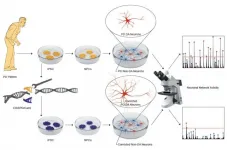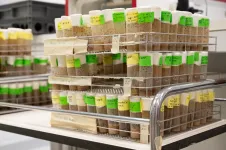INFORMATION:
International team aims to make musculoskeletal health a global priority
2021-07-07
(Press-News.org) An international research team has found that despite being the world's leading cause of pain, disability and healthcare expenditure, the prevention and management of musculoskeletal health, including conditions such as low back pain, fractures, arthritis and osteoporosis, is globally under-prioritised and have devised an action plan to address this gap.
Project lead, Professor Andrew Briggs from Curtin University said more than 1.5 billion people lived with a musculoskeletal condition in 2019, which was 84 per cent more than in 1990, and despite many 'calls to action' and an ever-increasing ageing population, health systems continue to under-prioritise these conditions and their rehabilitation requirements.
"One of the limiting factors to reform efforts is that no global-level strategic response to the burden of disability has been developed - until now. This novel data-driven initiative will be critical to guiding global-level work in health reform, such as that undertaken by the World Health Organization," Professor Briggs said.
"Addressing musculoskeletal health requires more than just healthcare reform - it requires inter-ministerial prioritisation and co-operation and collaboration with industry, transport and the built environment."
In response to a targeted call by the Global Alliance for Musculoskeletal Health (G-MUSC) headquartered at the University of Sydney, the international team of researchers mapped the current global landscape for the prevention and management of musculoskeletal health, identified current trends in national health policies and developed a blueprint to prioritise musculoskeletal health reform efforts in eight key areas.
Professor Lyn March from the University of Sydney said the blueprint was structured around critical areas for health systems reform, including community education; leadership and governance; health financing models; service delivery models that support integrated and person-centred care; equitable access to medicines and technologies; building capacity in the health workforce to deliver the right care at the right time; population health surveillance; and research and innovation.
"Each area is supported by detailed actions and priorities that countries may choose to adopt to build capacity in their health systems," Professor March said.
"Importantly, the blueprint is informed by people who work across all areas of health, and, critically, people with lived experience of musculoskeletal conditions.
"This blueprint is practical and can inform what a global strategic response might look like and how countries can respond to musculoskeletal health in order to arrest the increasing global burden of disability and cost."
Professor Helen Slater from Curtin University said the blueprint was developed with input from a panel of almost 700 stakeholders from 72 countries, representing 116 organisations.
"The research found global-level guidance, such as from the World Health Organization, is needed for country-level responses on musculoskeletal health and this blueprint provides that guidance which countries, including low and middle-income countries, can then adapt to suit local needs and priorities," Professor Slater said.
The work will now be considered by global agencies such as WHO and shared widely across countries, organisations and disciplines so that musculoskeletal health is integrated with other health reform initiatives in lifecourse and ageing, rehabilitation, non-communicable disease, and injury and trauma.
The project was funded by the Bone and Joint Decade Foundation, with additional funding provided by Curtin. The international team of researchers are from: Curtin University; Kolling Institute and University of Sydney; University of Toronto; Canadian Memorial Chiropractic College, Kathmandu University and the University of Southern Denmark.
Two research papers will be published in Global Health Research and Policy and BMJ Global Health and the resulting report 'Towards a global strategy to improve musculoskeletal health' will be published on the Global Alliance for Musculoskeletal Health website.
ELSE PRESS RELEASES FROM THIS DATE:
Beyond 5G: Wireless communications may get a boost from ultra-short collimating metalens
2021-07-07
Screens may be larger on smartphones now, but nearly every other component is designed to be thinner, flatter and tinier than ever before. The engineering requires a shift from shapely, and bulky lenses to the development of miniaturized, two-dimensional metalenses. They might look better, but do they work better?
A team of Japan-based researchers says yes, thanks to a solution they published on July 7th in Applied Physics Express, a journal of the Japan Society of Applied Physics.
The researchers previously developed a low-reflection metasurface -- an ultra-thin interface that can manipulate electromagnetic ...
Identified an early neuronal dysfunction in Parkinson's that could help early diagnosis
2021-07-07
Researchers from IDIBELL and the University of Barcelona (UB) have described that neurons derived from Parkinson's patients show impairments in their transmission before neurodegeneration.
For this study, it has been used dopaminergic neurons differentiated from patient stem cells as a model.
Parkinson's is a neurodegenerative disease characterized by the death of dopaminergic neurons. This neuronal death leads to a series of motor manifestations characteristic of the disease, such as tremors, rigidity, slowness of movement, or postural instability. In most cases, the cause of the disease is unknown, however, mutations in the LRRK2 gene are responsible for 5% of cases.
Current therapies against Parkinson's are focus on alleviating the symptoms but do not stop its progression. It ...
Changes in Earth's orbit enabled the emergence of complex life
2021-07-07
Scientists at the University of Southampton have discovered that changes in Earth's orbit may have allowed complex life to emerge and thrive during the most hostile climate episode the planet has ever experienced.
The researchers - working with colleagues in the Chinese Academy of Sciences, Curtin University, University of Hong Kong, and the University of Tübingen - studied a succession of rocks laid down when most of Earth's surface was covered in ice during a severe glaciation, dubbed 'Snowball Earth', that lasted over 50 million years. Their findings are published in the journal Nature Communications.
"One ...
A universal approach to tailoring soft robots
2021-07-07
By combining two distinct approaches into an integrated workflow, Singapore University of Technology and Design (SUTD) researchers have developed a novel automated process for designing and fabricating customised soft robots. Their method, published in Advanced Materials Technologies, can be applied to other kinds of soft robots--allowing their mechanical properties to be tailored in an accessible manner.
Though robots are often depicted as stiff, metallic structures, an emerging class of pliable machines known as soft robots is rapidly gaining traction. ...
Wolbachia and the paradox of growth regulation
2021-07-07
Despite having been formalized as a species in 1936, Wolbachia pipientis remains an elusive microbe. The reason why relates to the relationship it establishes with its hosts. Wolbachia lives inside the cells of 40% of the arthropods, in their majority insects, intertwined in a symbiosis so complex that it can no longer survive on its own. "Guessing what it takes to grow and manipulate it outside the host might not be possible", says Luís Teixeira, IGC principal investigator. And, so far, despite countless attempts, no one has succeeded in culturing this bacterium or modifying its genetic sequence.
Before joining the team led by Luís Teixeira, Elves Duarte was interested in studying the symbiosis between ...
Researchers clarify reasons for low rate of employment among people with disabilities
2021-07-07
East Hanover, NJ. July 7, 2021. A team of researchers identified nine meaningful reasons that prevent people with disabilities from seeking employment. Their findings provide a much-needed understanding of this population's motives for remaining unemployed, which can inform programs and policies that promote labor force participation of people with disabilities. The article, "Understanding Persons with Disabilities' Reasons for Not Seeking Employment" (doi: 10.1177/00343552211006773) was published in Rehabilitation Counseling Bulletin on April 15, 2021.
The authors are Denise C. Fyffe, PhD, Anthony H. Lequerica, PhD, and John O'Neill, PhD, of Kessler Foundation; Courtney Ward-Sutton, PhD, and Natalie F. Williams, PhD, of Langston University; and Vidya Sundar, OT, PhD, ...
How seeds know it's a good time to germinate
2021-07-07
Palo Alto, CA--Dehydrated plant seeds can lay dormant for long periods--over 1,000 years in some species--before the availability of water can trigger germination. This protects the embryonic plant inside from a variety of environmental stresses until conditions are favorable for growth and survival. However, the mechanism by which the baby plant senses water and reactivates cellular activity has remained a mystery until now.
New work jointly led by Carnegie's Yanniv Dorone and Sue Rhee and Stanford University's Steven Boeynaems and Aaron Gitler discovered a protein that plays a critical "go, or no-go" role in this process--halting germination if the soil's hydrological conditions are ...
CNIO researchers help to decipher the structure of the large molecular machine that activates mTOR
2021-07-07
The principle that form follows function does not only apply to design and architecture. It also applies to biology. Every organism is a universe that lives thanks to the activities of tens of thousands of nanomachines, whose functions depend on their forms. Biologists say macromolecular complexes instead of nanomachines and structure instead of form, but the idea is the same: know the form and you will understand the function. Now, a group at the Spanish National Cancer Research Centre (CNIO) has helped determine the structure of a nanomachine essential for the functioning of another, mTOR, which plays fundamental roles in ...
AI predicts diabetes risk by measuring fat around the heart
2021-07-07
A team led by researchers from Queen Mary University of London has developed a new artificial intelligence (AI) tool that is able to automatically measure the amount of fat around the heart from MRI scan images.
Using the new tool, the team was able to show that a larger amount of fat around the heart is associated with significantly greater odds of diabetes, independent of a person's age, sex, and body mass index.
The research is published in the journal Frontiers in Cardiovascular Medicine and is the result of funding from the CAP-AI programme, which is led by Barts Life Sciences, a research and innovation partnership between Queen Mary University of London and Barts Health NHS Trust.
The distribution of fat in the body can influence a person's ...
Mucus and mucins may become the medicine of the future
2021-07-07
Many people instinctively associate mucus with something disgusting, but in fact, it has incredibly many valuable functions for our health. It keeps track of our important intestinal flora and feeds the bacteria. It covers all internal surfaces of our body, and, as a barrier to the outside world, it helps us protect ourselves from infectious diseases.
This is because mucus acts as a filter that keeps the bacteria in or out, and the bacteria feed on the sugars in the mucus between meals. So, if we can produce the mucus that is already present in the body with the right sugars, it might be used in brand new medical treatments.
Now, researchers from the DNRF Centre ...




